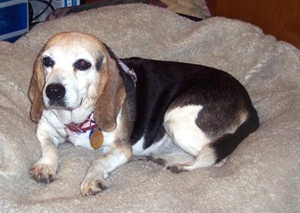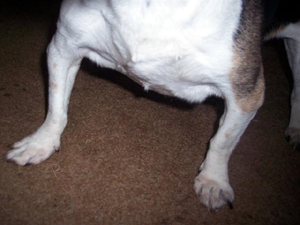NEW!!! Beagle Genetics Summary from Dr. Neff--October 2007
On January 18 2007, Dr. Mark Neff of U.C. Davis called CWBC President Claudia Anderson to tell her that the previous day he had a significant breakthrough 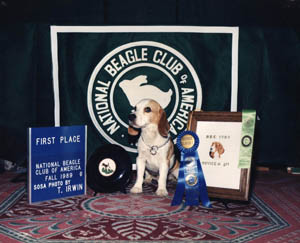 in identifying the genetic marker for chondrodystrophy. Dr. Neff told Claudia that they have narrowed the location of the mutation that causes chondrodystrophy to 30 genes in the same region on chromosome 6. While more research will need to be done to further determine the exact genes involved, Dr. Neff stated that with the information they have, they can begin to say that a specific Beagle does or does not carry the gene that causes the dwarfing condition.....".
in identifying the genetic marker for chondrodystrophy. Dr. Neff told Claudia that they have narrowed the location of the mutation that causes chondrodystrophy to 30 genes in the same region on chromosome 6. While more research will need to be done to further determine the exact genes involved, Dr. Neff stated that with the information they have, they can begin to say that a specific Beagle does or does not carry the gene that causes the dwarfing condition.....".
DNA samples of affected beagles and close relatives are still needed for this research. You can e-mail Dr.Mark Neff or
his assistant KRRobertson for more information on submitting swabs. Please send pedigrees to Darlene Stewart
Beagles affected. with chondrodystrophy of "dwarfism" can be affected in varying degrees. Some have major defects as pictured below and others mildly 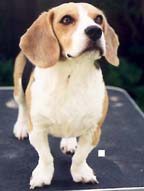 affected. Many survive well in geriatric years and are beloved pets. Some have competed in obedience. Below is a techincal description of the genetic disorder. Here is a link to a story about a beagle affected with this disorder. At the bottom of the page are also additional pictures.
affected. Many survive well in geriatric years and are beloved pets. Some have competed in obedience. Below is a techincal description of the genetic disorder. Here is a link to a story about a beagle affected with this disorder. At the bottom of the page are also additional pictures.
This excerpt is from the CWBC Newsletter. To read the entire article please use this link. Use your back button to return to this page.
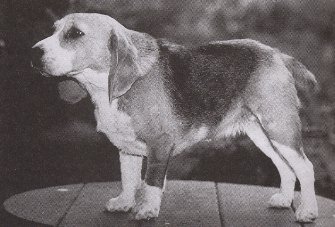 Beagle
with severe chondrodystrophy.Note the shortened neck, curved back and deformed front and rear legs. Picture by Diane Quenell, published in The New Beagle. 1998 Edition (see ordering link below) Permission for posting by authors. Beagle
with severe chondrodystrophy.Note the shortened neck, curved back and deformed front and rear legs. Picture by Diane Quenell, published in The New Beagle. 1998 Edition (see ordering link below) Permission for posting by authors. |
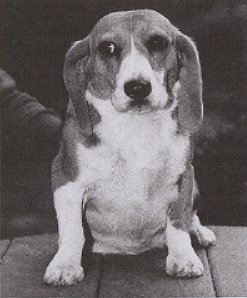 Note the position of the front legs. Picture by Diane Quenell, published in The New Beagle. 1998 Edition. Note the position of the front legs. Picture by Diane Quenell, published in The New Beagle. 1998 Edition. |
"Chondrodystrophy, also known as Chondrodysplasia and "the Funnies,"
is a kind of "dwarfism" caused by abnormal growth in the leg bones and vertebrae
of dogs. Beagle puppies who are born with the disorder usually exhibit signs
about 3 weeks of age. Usually they are significantly delayed in walking or they
start walking normally, and then suffer a collapse that inhibits them from walking.
The effects of the disorder range from mild to severe. In mild cases the dog may
have periodic bouts of pain while growing, but these can be managed with pain
medication and the dog can live a fairly normal life. In severe cases, the dog is
crippled to the point that euthanasia is the most humane choice."
A beagle with this genetic problem will often have crooked
front legs, a short neck, a large head, a curved back and an awkward gait.
"Most breeders rely on the appearance and behavior of the puppies to 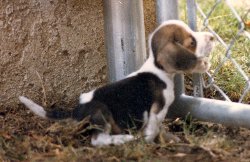 diagnose
Chondrodystrophy. However, a more definitive diagnosis can be obtained
through X-rays. X-rays of an affected dog will show abnormalities in the bony
growth centers of the long bones and vertebrae. There is also evidence that
Chondrodystrophy affected Beagles lack sinus cavities. The best time to diagnose
the disorder is around 8 weeks, although x-rays will show the disorder as early as
3 weeks. By the time the dog is four months old, the changes in the bone will make
the diagnosis more difficult. For a more thorough description of the disorder,
readers may wish to consult "The New
Beagle" by Drs. Judith and Anton Musladin and Ada Lueke. (pictured puppy at six weeks of age-note large head.)
diagnose
Chondrodystrophy. However, a more definitive diagnosis can be obtained
through X-rays. X-rays of an affected dog will show abnormalities in the bony
growth centers of the long bones and vertebrae. There is also evidence that
Chondrodystrophy affected Beagles lack sinus cavities. The best time to diagnose
the disorder is around 8 weeks, although x-rays will show the disorder as early as
3 weeks. By the time the dog is four months old, the changes in the bone will make
the diagnosis more difficult. For a more thorough description of the disorder,
readers may wish to consult "The New
Beagle" by Drs. Judith and Anton Musladin and Ada Lueke. (pictured puppy at six weeks of age-note large head.)
Chondrodystrophy is a genetic disorder that occurs in other breeds, as well as
Beagles. Chondrodystrophy has been well researched in Alaskan Malamutes. The
research with Alaskan Malamutes determined that the genetic inheritance of the
disorder is a simple recessive - that is, the sire and dam must each carry a gene
in order to produce a puppy affected with Chondrodystrophy (Journal of the American
Veterinary Radiology Society, May/June, 1975). Without researching the
disorder specifically in Beagles, one cannot say
for certainty that what is true of Alaskan Malamutes is true of Beagles. "
The following information is from an article printed in the
Columbia-Willamette Beagle Club November 2000 Newsletter. The article was written by
Dr. Mark Neff from Berkeley University. Excerpts are published here
with permission from the Beagle Bugler Editor.
"DIAGNOSTIC: Previous research showed that affected pups exhibited
radiographic punctate ossifications in the metacarpals and metatarsals. This was
confirmed with radiographs of pups from our pedigree. However, this method of
diagnosis was limited in that older animals (> 7 weeks) no longer exhibited these
signs. With the help of several veterinarians, we found a common feature among older
affected dogs a compressed seventh lumbar vertebrae (L7). This key finding
allowed for all dogs to be definitively diagnosed radiographically, either by the presence
of punctate ossifications (< 7 weeks) or by a compressed L7 vertebrae (> 7 weeks)
(see figures below).


GENETICS:Beagle Chondrodysplasia: We assembled a large multi-generation pedigree of
beagles (n = 354) that segregated rhizomelic dwarfism resembling human chondrodysplasia
punctata. The beagle disease segregated with an apparent autosomal recessive mode of
inheritance, although a significant deviation from the expected ratio existed between the
sexes (9 males and 22 females).....Several disease phenotypes showed variable expressivity
(e.g., dwarfism) or incomplete penetrance (e.g., closure of the frontal sinuses)."
What does all that mean???- Basically the mode of
inheritance is "thought" to be autosomal recessive with varying degrees of
expression or incomplete penetrance. This means that to have the syndrome a beagle
must have inherited a recessive gene from both parents. Both parents are a
carrier. Each affected beagle may exhibit a different severity of the disease
with some only being mildly affected and others being severly affected-thus "varying
degrees of expression or incomplete penetrance." Littermates may be carriers
and this genetic time bomb may not appear again for many generations. Careful study of
potential breeding partners of any litter mates should be done to identify "at
risk" pedigrees. Research to identify a genetic marker was underway but in 2001 was
cancelled due to lack of funding. Any beagle affected SHOULD NOT be
bred.
PROGNOSIS: Mildly affected beagles can live long lives
and tend to be very people oriented since they usually get extra attention and handling as
puppies. More severly affected beagle may have to be euthanized, especially if other
genetic problems appear as well. Often seen with chondrodysplasia are bad bites,
left eye cataract, short toes, early dental disease, and failure to thrive. Many do
not survive until adulthood.
For more information about this genetic problem please read
the information in "THE NEW BEAGLE".
 in identifying the genetic marker for chondrodystrophy. Dr. Neff told Claudia that they have narrowed the location of the mutation that causes chondrodystrophy to 30 genes in the same region on chromosome 6. While more research will need to be done to further determine the exact genes involved, Dr. Neff stated that with the information they have, they can begin to say that a specific Beagle does or does not carry the gene that causes the dwarfing condition.....".
in identifying the genetic marker for chondrodystrophy. Dr. Neff told Claudia that they have narrowed the location of the mutation that causes chondrodystrophy to 30 genes in the same region on chromosome 6. While more research will need to be done to further determine the exact genes involved, Dr. Neff stated that with the information they have, they can begin to say that a specific Beagle does or does not carry the gene that causes the dwarfing condition.....". affected. Many survive well in geriatric years and are beloved pets. Some have competed in obedience. Below is a techincal description of the genetic disorder. Here is a link to a story about a beagle affected with this disorder. At the bottom of the page are also additional pictures.
affected. Many survive well in geriatric years and are beloved pets. Some have competed in obedience. Below is a techincal description of the genetic disorder. Here is a link to a story about a beagle affected with this disorder. At the bottom of the page are also additional pictures. Beagle
with severe chondrodystrophy.Note the shortened neck, curved back and deformed front and rear legs. Picture by Diane Quenell, published in The New Beagle. 1998 Edition (see ordering link below) Permission for posting by authors.
Beagle
with severe chondrodystrophy.Note the shortened neck, curved back and deformed front and rear legs. Picture by Diane Quenell, published in The New Beagle. 1998 Edition (see ordering link below) Permission for posting by authors. Note the position of the front legs. Picture by Diane Quenell, published in The New Beagle. 1998 Edition.
Note the position of the front legs. Picture by Diane Quenell, published in The New Beagle. 1998 Edition. diagnose
Chondrodystrophy. However, a more definitive diagnosis can be obtained
through X-rays. X-rays of an affected dog will show abnormalities in the bony
growth centers of the long bones and vertebrae. There is also evidence that
Chondrodystrophy affected Beagles lack sinus cavities. The best time to diagnose
the disorder is around 8 weeks, although x-rays will show the disorder as early as
3 weeks. By the time the dog is four months old, the changes in the bone will make
the diagnosis more difficult. For a more thorough description of the disorder,
readers may wish to consult
diagnose
Chondrodystrophy. However, a more definitive diagnosis can be obtained
through X-rays. X-rays of an affected dog will show abnormalities in the bony
growth centers of the long bones and vertebrae. There is also evidence that
Chondrodystrophy affected Beagles lack sinus cavities. The best time to diagnose
the disorder is around 8 weeks, although x-rays will show the disorder as early as
3 weeks. By the time the dog is four months old, the changes in the bone will make
the diagnosis more difficult. For a more thorough description of the disorder,
readers may wish to consult 

